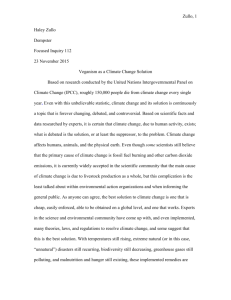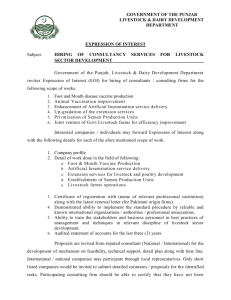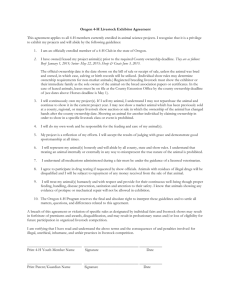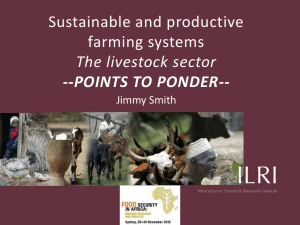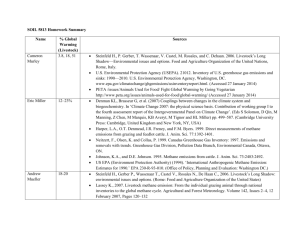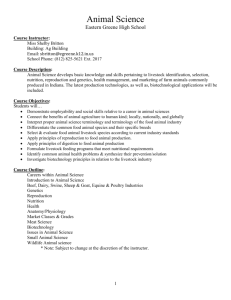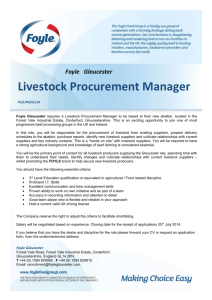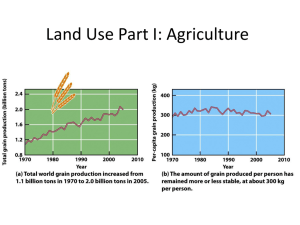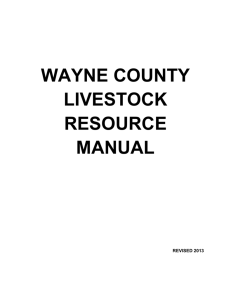Draft 3 - Rampages
advertisement
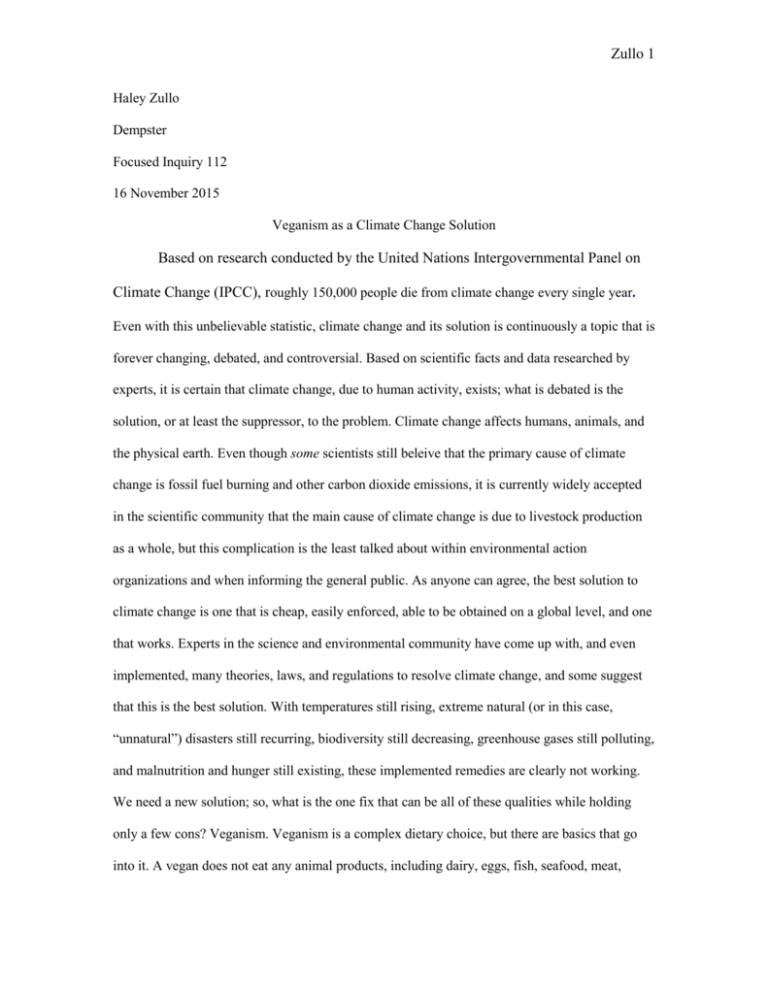
Zullo 1 Haley Zullo Dempster Focused Inquiry 112 16 November 2015 Veganism as a Climate Change Solution Based on research conducted by the United Nations Intergovernmental Panel on Climate Change (IPCC), roughly 150,000 people die from climate change every single year. Even with this unbelievable statistic, climate change and its solution is continuously a topic that is forever changing, debated, and controversial. Based on scientific facts and data researched by experts, it is certain that climate change, due to human activity, exists; what is debated is the solution, or at least the suppressor, to the problem. Climate change affects humans, animals, and the physical earth. Even though some scientists still beleive that the primary cause of climate change is fossil fuel burning and other carbon dioxide emissions, it is currently widely accepted in the scientific community that the main cause of climate change is due to livestock production as a whole, but this complication is the least talked about within environmental action organizations and when informing the general public. As anyone can agree, the best solution to climate change is one that is cheap, easily enforced, able to be obtained on a global level, and one that works. Experts in the science and environmental community have come up with, and even implemented, many theories, laws, and regulations to resolve climate change, and some suggest that this is the best solution. With temperatures still rising, extreme natural (or in this case, “unnatural”) disasters still recurring, biodiversity still decreasing, greenhouse gases still polluting, and malnutrition and hunger still existing, these implemented remedies are clearly not working. We need a new solution; so, what is the one fix that can be all of these qualities while holding only a few cons? Veganism. Veganism is a complex dietary choice, but there are basics that go into it. A vegan does not eat any animal products, including dairy, eggs, fish, seafood, meat, Zullo 2 poultry, etc. Dietary restrictions such as veganism have become practiced because of many different reasons; some include health, allergies, animal sympathy, and a more recently proposed reason: the suppression, impeding, and slowing down of climate change. Throughout the past years, climate change has been a topic of conversation in the scientific, news, and political communities, along with many others. Even though climate change deniers still exist, climate change has been proven to an almost certain extent. The controversial parts of climate change now include the primary cause and the solution. Some scientists still accept fossil fuel burning as the main cause for climate change, but the majority of the scientific community has researched and proven that the main cause is, in fact, livestock production. Through extensive research and testing, Anderson T. Scott and Baylee L. Campbell are able to claim, in Emissions of Methane and Nitrous Oxide from Natural Sources, that livestock production is the main cause for negative climate transformation. The evidence specifically shows that only 37% of methane emissions is from natural sources and the other 63% is from unnatural and human-made sources, hence livestock production. Specifically, from “anthropometric,” man-made sources, methane pollution holds a value of 610, demonstrating the high impact livestock has (6). Livestock production as a main cause of climate change can also be shown through evidence of the past. To demonstrate by statistics, Luke Jones, a researcher for the acclaimed documentary, Cowspiracy, reports, “51% of greenhouse gas emissions (GHG) are due to livestock and their byproducts while only 13% is due to transport.” On the contrary to what the general population is told, GHGs (Nitrous Oxide) are even more harmful to the earth than excess carbon dioxide emissions. Livestock has been responsible for 65% of these emissions (Jones). In addition to GHG emissions, livestock production has been linked to biodiversity (the variety of species on the earth) loss. As stated by Jones, “110 animal and insect species are lost every day from animal agriculture. It is the leading cause of species extinction…” Biodiversity loss is a huge side-effect of this, especially in Less Economically Developed Countries (LEDCs). LEDCs tend to be the most naturally biodiverse, and in LEDCs, livestock production is very high because Zullo 3 it’s cheaper than agricultural development. This causes an even greater loss in biodiversity, which is imperative to the earth’s survival. Adding to these two problems with livestock production is malnutrition especially within LEDCs. As L. Baroni, et. al. put it, in Evaluating the Environmental Impact of Various Dietary Patterns Combined with Different Food Production Systems, the current livestock, meat, lipid, and fatty-acid heavy diets that are prevalent through LEDCs are malnutritious (220). High livestock production, of course, contributes highly to these poor diets. Through research, evidence, data, statistics, etc., it is easy to say that livestock production is one of the the most harmful methods of adverse impact for the environment; and again, we ask, what is one way that we can partially resolve this issue? Veganism. Based on the common diet currently consumed by the general population, the world is nowhere close to sustainability. To be sustainable, changes in the way humans eat need to take place. The best solution to climate change and impact is veganism. Based on evidence and scholarly predictions, veganism can be one way to help reduce land use, reduce methane and nitrous oxide (GHG) emissions, reduce malnutrition and hunger, and lead the world to sustainability. These facts can be successfully be proven with researched statistics that Toni Meier and Olaf Christen have published in Environmental Impacts of Dietary Recommendations and Dietary Styles: Germany As an Example. They found that GHG emissions per person, per year for a vegan is at a value of 1.0, with the common diet being at 2.3. The land use (in m2) per person, per year for the average person is at 2098 with a vegan being at only 1052. Overall, a vegan’s energy use is only 9.4 and the average diet is 4.1 points higher at 13.5. All of these statistics show how drastically veganism can change a person’s carbon footprint and, “There is a declining intensity [of impact] toward the vegan diet” (884). Water use is also greatly affected by change in diets. According to L. Baroni, et. al. in the current sustainability situation that the world is in, “70% of the total water consumption is due to agriculture, 22% is due to industry, and 8% is due to domestic uses” (225). Since this data is so extreme for agriculture, L. Baroni, et. al. came up with the probable solution of veganism and they claim that, “A shift in eating habits towards Zullo 4 the increase of the direct consumption of plant foods seems to be a desirable objective in this perspective. Owing to their lighter impact, confirmed also by our study, vegetarian and vegan diets could play an important role in preserving environmental resources and in reducing hunger and malnutrition in poorer nations” (285). The research, data analysis, and experiments that the authors have conducted successfully support this possibility of veganism as a solution and as a conclusion. For example, the number of resources used for an omnivorous diet is at a 0.798 value while a vegan diet has a value of 0.455, 0.334 lower than omnivorous, which is an extreme difference (285). With these facts, the authors claim that switching to less meat in diets would, perhaps, create a double positive: it would help malnutrition/hunger as well as the environment. To illustrate and reiterate all of these statistics, research shows, “A person who follows a vegan diet produces 50% less CO2, and uses 1/11th oil, 1/13th water, and 1/18th land compared to a meat eater” (Jones). If everyone in the world switched to veganism, these facts would conceivebly create a sustainable world; but, this request is unrealistic. Instead of asking the entire world to replace meat with plants, educating the world on the effects would become more effective to gaining sustainability. Overexploitation of livestock also can contribute to hunger and malnutrition, especially in LEDCs. Many believe that increasing livestock production and use in LEDCs is cheaper and will assist in ending hunger and malnutrition, but the opposite has also been implied to be true; higher production of plants and shifting to a plant-based diet is cheaper and more beneficial to decreasing hunger and malnutrition. A shift in eating habits towards veganism could possibly be highly beneficial to decreasing hunger and malnutrition, and this is successfully confirmed by research done by L. Baroni, et. al. Specifically, they say, “...confirmed also by our study, vegetarian and vegan diets could play an important role in pre-serving environmental resources and in reducing hunger and malnutrition in poorer nations” (285). These researchers also recommend that one way to accomplish this dietary shift would be through education of the diets and their importance. After thorough research, they write, “...[we] support the opportunity of Zullo 5 educating people living in developed countries to ‘change their attitude with regard to consumption and to individual behaviour’” (285). With this information, it is possible that the health of MEDCs would also increase with a shift in diet. Again, this is proven through research done by Anthony J. McMichael, et. al. and published in Food, livestock production, energy, climate change, and health. The authors claim that, “A substantial contraction in meat consumption in high-income countries should benefit health, mainly by reducing the risk of ischaemic heart disease, obesity, colorectal cancer, and, perhaps, some other cancers” (220). Through the educating of the importance of vegan and plant-based diets, such as volunteers and others working to educate, hunger could decrease in third world countries and health in developed and third world countries could increase. Regardless of the extensive research that has proven that methane emissions and livestock production are largely the reason for unnatural climate change, some scientists are still going to claim that fossil fuel burning is the primary cause. In, Emissions of Methane and Nitrous Oxide from Natural Sources, the EPA’s claim of the primary cause of climate change is different than other experts have suggested. Rather than admitting to livestock production being the main cause, they state that deforestation and fossil fuel burning are the two greatest contributors to negative environmental impact. In relation to fossil fuel’s environmental impact, based on research published by Scott and Campbell, the EPA declares that, “CH4 (methane) and N2O (nitrous oxide) are chemically stable and persist in the atmosphere over time scales of a decade (CH4) to centuries or longer (N2O)” (22). This claim means that while the EPA admits to these two gases being emitted, they don’t admit to the gases being the most harmful pollutants; the EPA is wrongly claiming that methane and nitrous oxide is stable and that an excess of the gas is not the largest cause in climate impact. Even though they claim this, the EPA has conducted research into methane gases and the environment -under the radar- which reveals that the emissions estimated from non-natural sources of methane is much higher than other sources of emissions; so what they actually claim to the public is opposite of what their research displays. Zullo 6 Despite conducting research that resulted in showing that methane is one of the most harmful gases to the environment, the EPA never actually posts any of this information on their website or publishes it in journals; it has only been published by third parties. The EPA vaguely claims, “...Although our understanding of the scope of possible changes in emissions has significantly increased over the past few years through model development and improvement, large unknowns still remain” (193). From saying that they still have a lot to discover and uncover, the EPA talks around the concept of livestock production being a predominant cause in climate change. Just as there is a second side to the cause of climate change, there is also a second side to the possible solutions. As said before, another refutation to the original argument is that of the solution. Whereas veganism seems to be the best solution, others may claim otherwise. In Carbon Footprint Analysis, by Defne Apul and Matthew John Franchetti, it is claimed that their certain approach to the solution will be most beneficial: “The Systems Approach to Project Implementation” (9). This explains how to create a law or regulation to help stall climate change. In their approach, these authors state, “‘If you can’t measure it, you can’t manage it.’ The purpose of this model is to quantify energy and GHG emissions and achieve the goals” (6). Instead of claiming veganism as the most preferred solution to environmental change, as many experts do, they are choosing something entirely different as a possible solution. They are saying that to end climate change, GHG emissions must be measured then policies must be created to slow this change. Based on other research done by scientists, this claim can be shown as slightly invalid because this method has been used before and is continuing to be used. As the statistics show though, climate change is still increaing, meaning this solution is not working. While there are claims by other accredited researchers that refute the original argument presented, that veganism is the most probable solution to helping climate change decrease, overall, this other side of the the argument is overshadowed and it can be said that veganism is, in fact, the best solution to the primary problem in climate change: livestock production. Zullo 7 One of the biggest pollutants of the earth is Green House Gases. This can include many different types of harmful gases. Based on statistics, primarily methane and nitrous oxide are proven to be the most harmful, both largely produced by overexploitation of livestock and livestock production. Despite the claim of certain scietists that fossil fuel burning is the primary cause, there has been extensive research by many more acclaimed researchers to confirm that livestock production is the primary cause and to come up with a new solution. Many solutions have been tested, such as policy change and implementation, but the most probable for actually helping to supress climate change has been suggested to be the converting of current common diets to veganism and other plant based diets. In conclusion, from more extensive research and data, experts have been able to prove that switching to veganism could play a role in helping the environment as well as reducing malnutrition and hunger and increasing world health. Word Count: 2,368 Words Zullo 8 Works Cited Apul, Defne, Matthew John Franchetti. Carbon Footprint Analysis. Boca Raton, FL: Taylor & Francis Group, 2013. Book. Baroni, L, L Cenci, M Tettamanti, and M Berati. Evaluating the Environmental Impact of Various Dietary Patterns Combined with Different Food Production Systems. European Journal of Clinical Nutrition. EBSCOhost Academic Search Complete, 2007. Web. 27 October 2015. Climate Change. n.p. The Health and Environment Linkages Initiatives. World Health Organization. Web. 10 November 2015. Jones, Luke. Cowspiracy. Cowspiracy: The Sustainability Secrets: The Facts. A.U.M Films. Web. 10 November 2015. Machovina, Brian, Kenneth J. Feeley, and William J. Ripple. ScienceDirect. Biodiversity Conservation: The Key is Reducing Meat Consumption. Science of the Total Environment. Virginia Commonwealth University, 29 July 2015. Web. 20 October 2015. Meier, Toni, Olaf Christen. Environmental Impacts of Dietary Recommendations and Dietary Styles: Germany As an Example. Environmental Science and Technology, 28 November 2012. Web. 29 October 2015. McMichael, Anthony J., John W. Powles, Colin D. Butler, Ricardo Uauy. Food, livestock production, energy, climate change, and health. ScienceDirect. The Lancelet, 6-12 October 2007. Web. 13 November 2015. Scott, Anderson T., Baylee L. Campbell. Emissions of Methane and Nitrous Oxide from Natural Sources. New York: Nova Science Publishers, Inc., 2012. Book.
